|
Enterprise Storage Solutions For Data & Document Management
Document Management in the enterprise
By Larry Bowden, Director of Interactive Enterprise Marketing
IBM Software Group
Is your organization among the "information-challenged?" Are customer service representatives or account-receivable specialists searching through microfiche for a customer statement or invoice while an unhappy customer is on the telephone asking, "Don't you have the fax I sent you and my last month's transactions available?" Are production planners and brand managers frantically trying to locate internally created white papers and presentations-plus industry analyst reports and documents retrieved from the World Wide Web-to deliver a new product launch plan or marketing strategy to your business partners, potential investors, your sales force or advertising agency? If you can identify with any of the above read on.
Knowledge is the primary competitive asset of an institution. The ability to capture and manage this knowledge base is critical to the success and survival of any organization, large or small. The challenge for the effective enterprise is to gain quick access to this valuable knowledge and information, regardless of format or type or where it resides in the organization. This white paper will explore the three key factors that comprise document management in the information enterprise-the users, the application and the challenges the enterprise must solve. It will also provide some insight into how to plan an effective enterprisewide document management strategy.
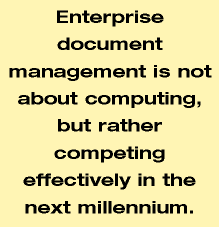
Today's business executives face great economic, organizational and competitive pressures. Product, service and market strategies change unpredictably, while organizational structures and job roles are continuously revised. There is an ever increasing need to improve customer service to gain a competitive advantage, and at the same time, businesses are required to bring down operational costs. This has necessitated downsizing for many firms and increased the need to manage high turnover of the work force, placing businesses under additional stress. This constant need to react quickly to changing circumstances demands rapid access to all needed information, and sharing and communicating it effectively to employees across the enterprise. All of this has increased the role of information in managing the enterprise.
For the purpose of this paper, the term document refers to unstructured information of any type that was created for use in transacting business within the enterprise. Over the last 40 years, the tools and techniques to process structured information, fields and records, rows and columns have continued to evolve from databases to data warehouses to data mining. The last 10 years have seen a new set of technologies emerge, focused on unstructured information for documents. Industry analysts report that 90% of the available information is unstructured data. This includes scanned document images, faxes, photographs, computer-generated reports and statements, word-processing documents, spreadsheets, presentations, audio and video clips-all created and captured from various sources within and outside the company, in different systems from different vendors. The importance of gaining control of the document and the data within it cannot be overemphasized. For the companies that do this effectively, the doors to the wealth of information already locked in document vaults across the enterprise now will be available to support the short- and long-term decisions that must be made across the company. It will be easier than ever to assemble a complete picture of customer and supplier relationships, understand and communicate new product information to whomever needs it, and provide immediate, up-to-date access to information about the competition. This will be achieved through the use of easy-to-learn tools that rapidly search, manipulate and present different types of data in a single view.
Enterprise document management is not about computing, but rather competing effectively in the next millennium.
The information enterprise the users
The information enterprise consists of three key categories of information users:
- production users who spend the majority of their time accessing a small number of well-defined, document-enabled applications;
- ad hoc users who work both independently and within workgroups, needing access to document repositories throughout the enterprise;
- customer users outside the enterprise who are authorized to access specific multiple document repositories using Internet technologies.
The production user
These are the users of systems that support high throughput of repeated processes accessing any multimedia data type, typically document images and computer output to laser disc (COLD) records. Their activities are typically highly controlled by process-centric applications. Examples include claims processing, customer service, accounts payable, loan processing, credit approval among others. The information management solutions they employ are usually departmental and associated with a known, specific set of document servers and archive systems. The users perform a well-defined, transaction-oriented set of functions in the environment, where the system security, performance and availability are critically important. Common requirements of these users include:
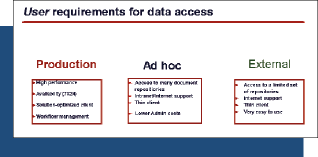
* functionally rich client software,
* minimal number of user interactions per transaction,
* high system performance with fast response time,
* continuous system availability,
* strong emphasis on access security,
* access to one or two document servers.
The ad hoc user
These users are often referred to as knowledge workers and deal with a broader set of business issues than production users. They need to access numerous sources of enterprise data with limited ability to predict and configure ahead of time. Of paramount importance are ease of use and simplified access for large numbers of users to multiple heterogeneous sources of data within and outside the enterprise. Forward thinking companies are planning to give this type of access to many enterprise employees, providing them with a document-centric decision support system capability. These users typically require:
* very simple, "thin" client software
* efficient, intelligent search capability
* ability to query multiple sources and combine the results into a single view
* intranet support for data access
* desktop applications for document creation
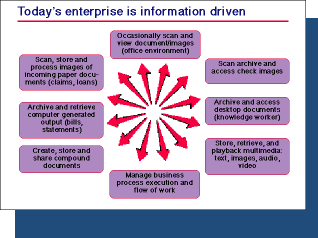
The external user
As the enterprise seeks to gain competitive advantage, improve customer service and to meet the changing needs of the future, many will use the Internet and its accessibility as a means to support customer self-serve for both business-to-business and consumer markets. The need for these users is similar to the ad hoc usage except that it requires an even easier to use "bulletproof" user interface. The enterprise must be assured that only authorized users have access to appropriate content.
The information enterprise the application
characteristics
Most enterprises already have a number of document management solutions, some developed to complement a specific business process, others developed to support the flow of information within the enterprise. The efficiency of these solutions inherently reflects in the bottom line of a company's financial results. Leveraging those investments and accessing the resultant document repositories is a critical challenge of an enterprise document management architecture.
Today, a number of document management solutions have been developed to support specific production processes. Additionally, a new class of software has been developed to address the unstructured needs of the ad hoc user and workgroups. Together they form the nucleus of the document management information systems for the new millennium. The major components of these systems are production imaging, COLD, document management, groupware and workflow management.
Production imaging--Production imaging supports a business process-driven set of solutions that use electronic imaging technology to reduce or eliminate paper handling. Production imaging supports applications that are typically industry-specific, such as insurance claims processing, financial loan application processing, to name a few. These involve converting paper documents to electronic images, indexing them for reference and future access, and linking them to the appropriate databases. These applications have been implemented for the past decade and are now as mission critical as the standard payroll applications.
COLD--Computer Output to Laser Disc systems have reduced paper printing and have replaced microfiche and microfilm applications as the means of storing computer-generated output such as reports, bank statements, telephone and utility bills, and similar information. COLD systems provide the functionality for indexing and storing structured computer-generated report data so that they can be stored economically and retrieved for viewing or printing on demand. These applications support the ability to provide improved customer service and increase accessibility to archived data.
Document management--Electronic document management is the means to capture, store, create, retrieve and control document-based information across it's life cycle from creation to archival. Desktop documents, such as word processor files, spreadsheets and presentation graphics, can be indexed and stored in electronic filing cabinets for easy search and retrieval. There is also a need for the management of large compound documents such as pharmaceutical filings and for product data management, such as engineering diagrams.
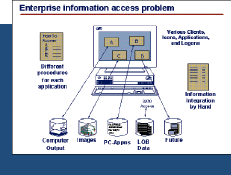 Groupware--Groupware allows users within the enterprise to collect, collaborate and coordinate the various information to support their changing work environment. It does this through a series of document-oriented databases that are the repository of the unstructured data. Through these databases, users can store multimedia data and retrieve the documents using robust text search engines. Today's groupware provides a seamless environment with a common user interface that allows the user to focus on their work rather than dealing with the technical complexities.
Groupware--Groupware allows users within the enterprise to collect, collaborate and coordinate the various information to support their changing work environment. It does this through a series of document-oriented databases that are the repository of the unstructured data. Through these databases, users can store multimedia data and retrieve the documents using robust text search engines. Today's groupware provides a seamless environment with a common user interface that allows the user to focus on their work rather than dealing with the technical complexities.
Workflow management--Workflow management uses database technology to provide a centralized management structure for business processes. Once the participants, information sources rules and flows of a business process are defined, they are stored in a database. By keeping process definitions separate from application programs, administrators can easily modify processes without the need to change programming. Workflow systems are highly structured, process-centric and can be very diverse. They reflect a multitude of activities from originating a purchase order to underwriting an insurance policy.
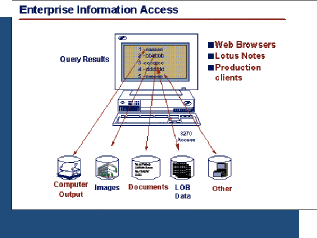 The Challenges the
The Challenges the
enterprise must solve
There are two basic questions that must be addressed by any user of the enterprise document management system. Does the information that a user is attempting to retrieve exist in some form within or outside the enterprise? If so, how can he or she gain access to it?
Over the last 10 years, organizations have archived vast amounts of documents. The core business processes were supported by independent, fine-tuned applications. The ability to integrate and share information between these applications and various databases was only a dream. Today, the challenge is complicated by new types of objects and the need to make all information available quickly to knowledge workers, in an intuitive manner.
The documents are there, but can you find them when you need them? Documents exist where they were deposited by the production application. Unfortunately, you still can't quickly collect the separate pieces you need to solve your problem. Years of storing documents have resulted in non-responsive information vaults within the enterprise.
Today, the challenge is using this data as a knowledge asset for your organization and to have the flexibility to use future technology with the same ease.
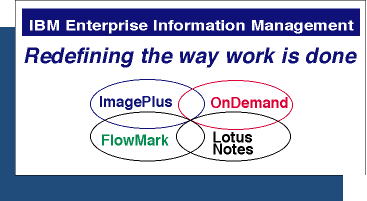 The ideal enterprise document information management system provides a user with the ability to ask a question and promptly receive an answer, regardless of where the data resides. Thus, the user is provided with the ability to respond to a request for information, devise plans for a new product or market strategies and ultimately be better prepared to compete in the global market.
The ideal enterprise document information management system provides a user with the ability to ask a question and promptly receive an answer, regardless of where the data resides. Thus, the user is provided with the ability to respond to a request for information, devise plans for a new product or market strategies and ultimately be better prepared to compete in the global market.
The enterprise document management suite
Is enterprise document management a solution today, or a dream for tomorrow? The answer lies in understanding the components of an enterprise solution and the design of an architecture that enables it. To be effective, the architecture must support seamless access to both the enterprisewide and the inter-enterprise document data sources. This implies the need for absolute flexibility to accommodate the needs of both production and ad hoc users. No one product will supply all your enterprise document management needs. No doubt it will take a selection that enables the effective utilization of a company's knowledge-bases.
At IBM, our focus is the enterprise. Customers have chosen us to provide computing solutions during the last half century. We know we must fit into your existing environment and be flexible to accommodate today's, as well as your future requirements. The modular document components of IBM's Enterprise Document Management Suite (EDMSuite) are in use at more than 3,500 customer sites today.
* ImagePlus--information without limits
* OnDemand--information on-line, on demand, on budget
* Lotus Notes--the power of people working together
* FlowMark--workflow across and beyond the enterprise
The key is to implement the individual component of choice, the one that best addresses a specific business problem, be it image or COLD or workflow. This can be done with the confidence that as other components are added in the future, they will easily work with each other.
Increasingly, organizations want to provide access to the various document repository investments, from multiple vendors, to a much larger set of ad hoc users across the enterprise via Intranets. Over time, access to external users, customers, clients and partners will be provided through "extranets" using Internet technology.
The ability to provide a single, simple interface for these ad hoc users to what have been separate "islands of information" is now possible. Its architecture provides the required flexibility through its open design to make enterprisewide document access to multiple sources of documents possible, via an IBM provided gateway component.
This environment requires a simple intuitive, familiar, ubiquitous interface- a standard web browser.
Queries for the documents are formulated by entering search criteria into web pages. The IBM gateway component extracts the search criteria and uses them to search the "federation" of one or more document libraries using powerful search engines. The libraries can be both IBM and non-IBM repositories. The architecture allows for easily adding new modular selectable search engines and additional "back-end" repository services. The results of the query, a consolidated view of the documents found, are presented back to the user at the web browser. The user then simply selects the documents they want to view or print.
Developing and implementing an enterprise document management system is clearly a complex task, requiring much planning and preparation. While contemplating how and when to make this move, it is possible to view it as a modular process. Because of the strength of the architecture, the entire enterprise need not be tackled at once. It does not matter where you start, as long as an architecture that provides for growth and flexibility is in place. The IBM architecture is capable of accomplishing any enterprise requirement, regardless of how complex, while allowing for the coexistence with many alternative product solutions.
Our highly trained, worldwide staff of document management specialists and consultants can assist you in planning your strategy for enterprise document management. They are prepared to support your needs from basic analysis of the system to providing full custom implementation. Some of the world's most respected organizations have relied on IBM for this level of support, and we stand ready to provide this same level of excellence to you and your organization.
Above all, if you are not currently considering an enterprise document management strategy and solution, you should be! Why? Because your competition is!
For more information on the IBM EDMSuite and how it can be deployed to enable your organization to be more effective and competitive, please call us at 800-IBM-2468, ext. DA136 or contact your local IBM sales representative.
Larry Bowden is director of IBM's Interactive Enterprise Marketing in the IBM Software Group. His responsibilities include IBM's Digital Library and IBM's Electronic Document Management Suite(EDMSuite). E-mail BOWDEN@ VNET.IBM.COM
|

![]()
![]()
